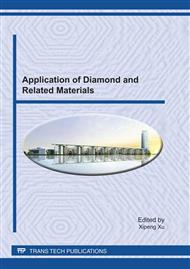p.87
p.93
p.97
p.102
p.107
p.112
p.116
p.121
p.126
Experimental Study on Damage Mechanism of Nano-Ceramic Surface/Subsurface under Ultrasonic Vibration Aided Grinding
Abstract:
In this paper, surface/subsurface damage mechanism of engineering ceramics under ultrasonic vibration assisted grinding was studied by experiment based on its theoretical study. The study shows: under the same grinding conditions, ultrasonic grinding can realize plastic grinding and low crack damage surface grinding in a larger range of cutting depth than that under common grinding, that can improve processing efficiency and reduce workpiece grinding damage. Meanwhile, ultrasonic vibration grinding process can be seen as periodical loading and unloading process of abrasive on the workpiece. Crack is formed and extends initially on loading, the speed of crack expansion slows down, and its direction offsets to workpiece free surface on unloading as the change of ultrasonic force direction. So cracks can not expand to material deep and shallow sub-surface cracks are left in workpiece sub-surface layer. This phenomenon may be one of the main reasons that subsurface damage is reduced on ultrasonic grinding.
Info:
Periodical:
Pages:
107-111
Citation:
Online since:
June 2011
Authors:
Price:
Сopyright:
© 2011 Trans Tech Publications Ltd. All Rights Reserved
Share:
Citation:


